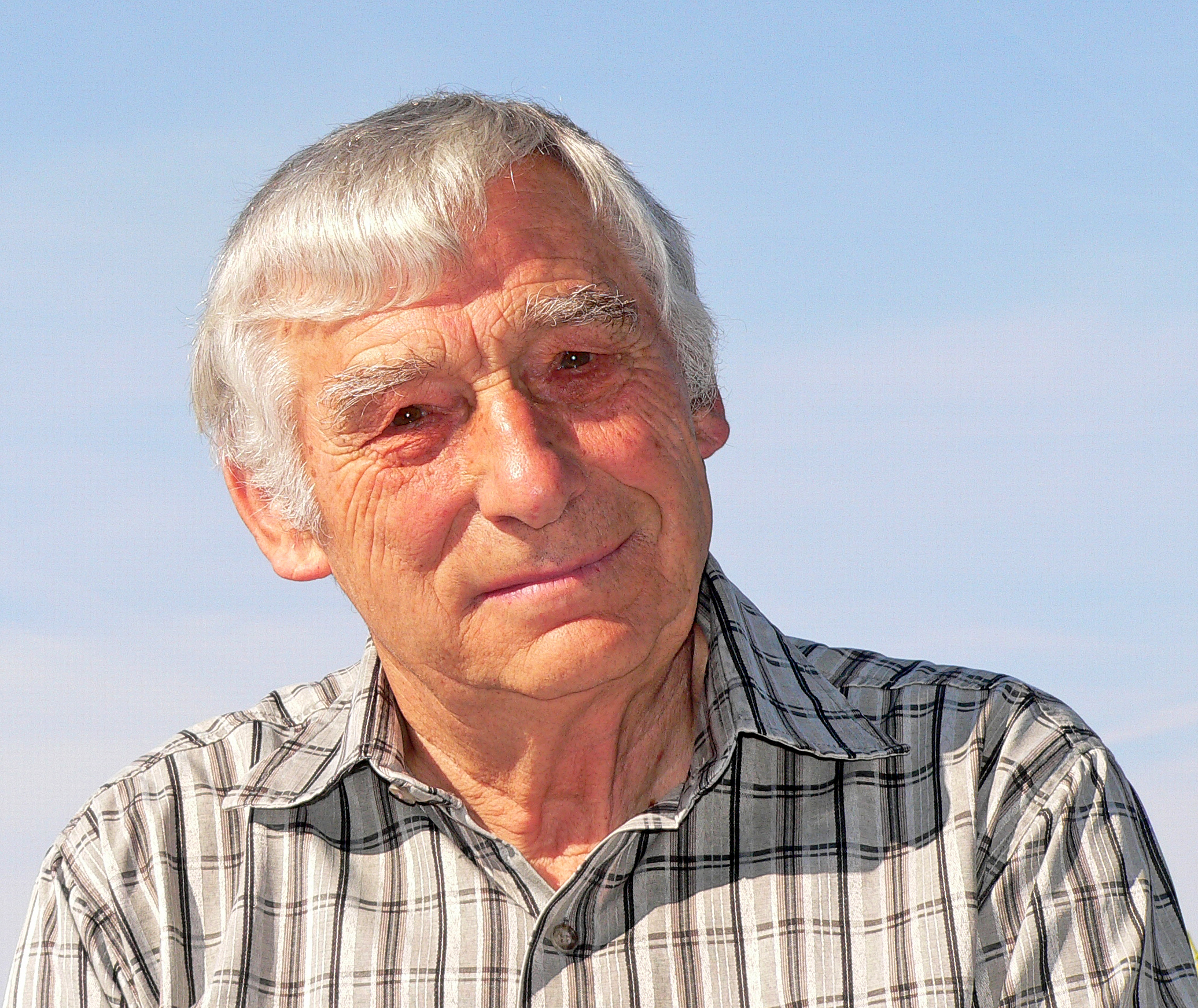Kaspar Bruehlmeier-Beetschen, the Emigrant (FT 150)
I initially mentioned that the whole research project was started because American descendants of a “Kaspar Bruehlmeier” were looking for their genealogical roots in Europe. We can split the remaining relatives in the USA into two groups:
-
One group (which is relatively closely related to me) descends from Leonhard Bruehlmeier (FT 67), mayor of Wettingen from 1905 to 1913. His son Emil (FT 88) immigrated to America in 1906. Leonhard’s grandson, Hans, (FT 274, the son of the Justice of the Peace, Hans Bruehlmeier-Lienberger, FT 85) made the move over the Atlantic Ocean in 1930. Both left two daughters each, which is why there are no more descendants of this line who carry on the name “Bruehlmeier”.
-
The other group (which is only remotely related to all Bruehlmeier still living in Switzerland) descends from the previously mentioned Kaspar Bruehlmeier. They call themselves either Meyer or Meyers and are very numerous. Until very recently, some of them were very proud of their German ancestry. Although they had a family tree extending all the way back to Kaspar, with practically no gaps, and despite the recently rediscovered documents clearly proving that Kaspar Bruehlmeier was Swiss, they believed a story that had been passed down through the generations since Kaspar’s arrival in the United States. This story claimed their ancestor was German and had immigrated to the USA in 1869 through Switzerland.
This second group was looking for persons called Bruehlmeier over the Internet. Thus, they found the first group before any contact to Europe had ever been established. The information chain of events began when my nephew, David, [that’s me, the translator] opened his own Homepage on the Internet [ www.bruehlmeier.com ] and was contacted by the researching Americans in June 1999. His reaction was mostly one of disinterest, since he knew he did not descend from Germany and because he did not know at the time that Wettingen is the only point of origin for our family name. In October 1999, another member of this group succeeded in finding the e-mail address of my son, Matthias, and uttered the supposition that we might be related. When two photographs arrived by e-mail from America (from the first group), featuring the family of my great-grandfather, Leonhard, and my grandfather, Josef, (Kuefer) and also my own father, it was clear to everybody that this contact would yield results.
The two photographs that were sent from America through the Internet.
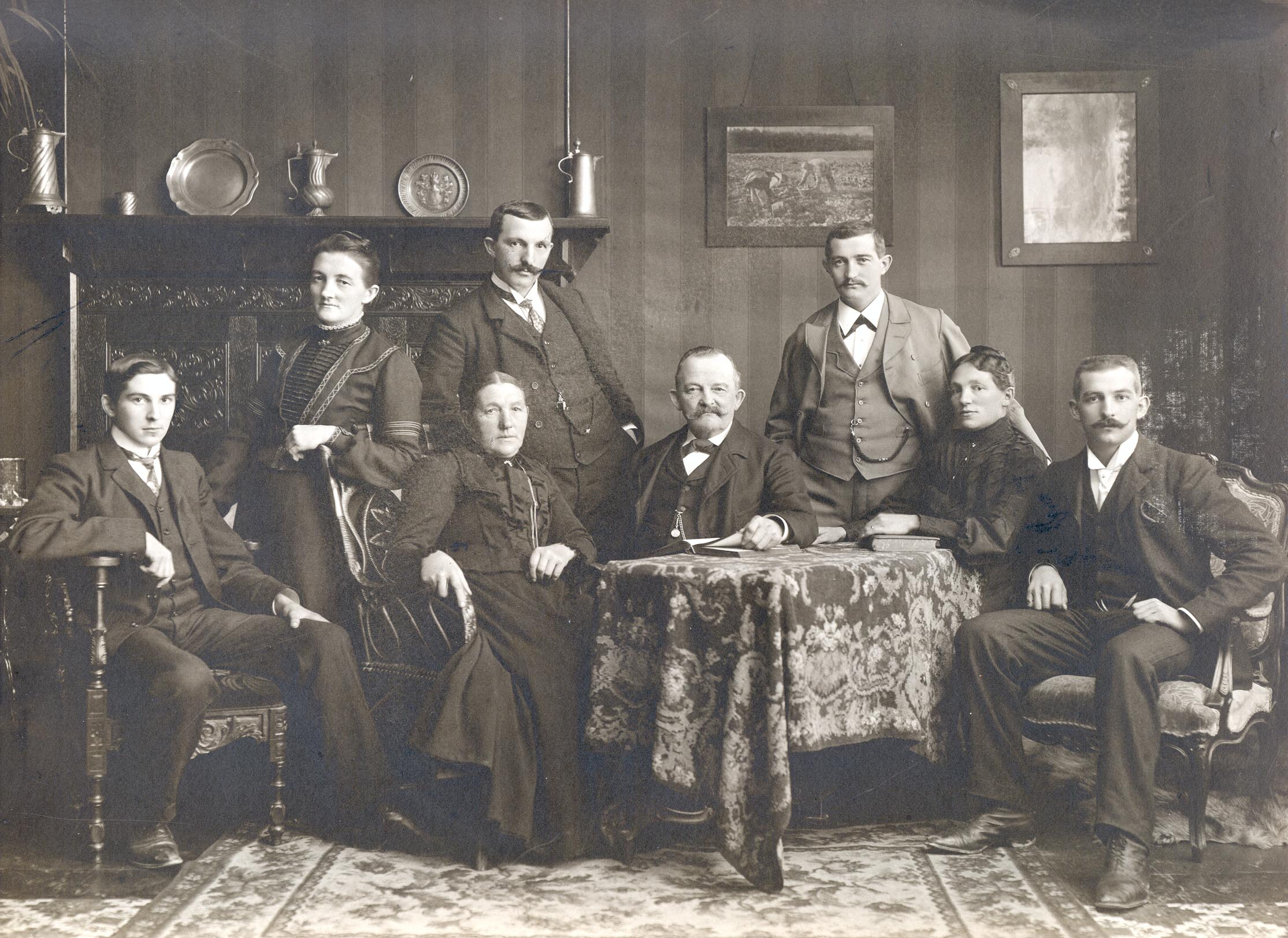
Mayor Johann Philipp Leonhard Bruehlmeier and his wife Josefine Elisabetha (maiden name: Zehnder) and the children (from left to right) Emil, Maria Rosa, Oswald, Josef (Kuefer), Genofeva, Hans (justice of the peace)
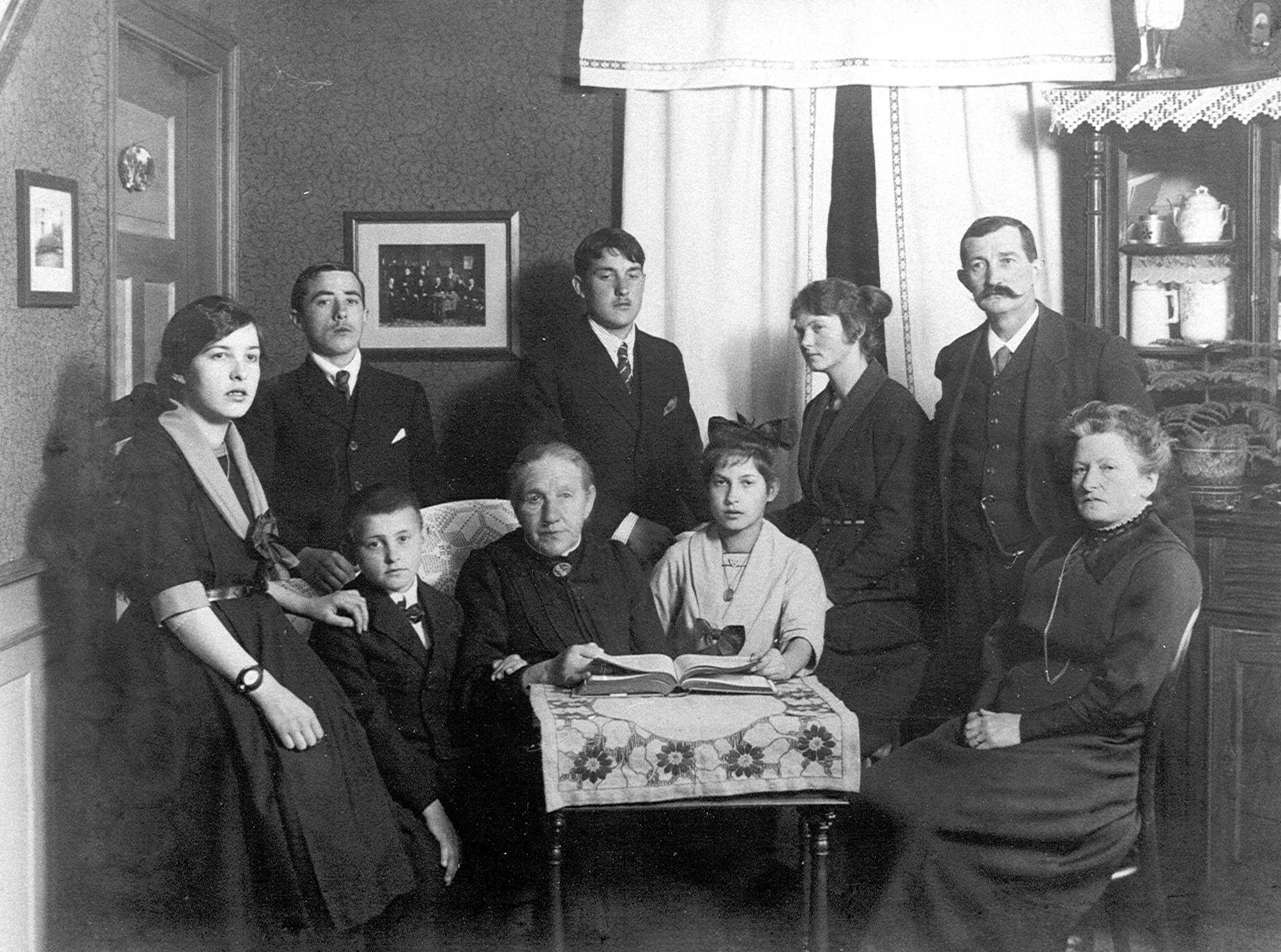
Family of Kuefer [Barrel Maker] Josef Bruehlmeier. From left to right, standing: Paula, Walter, Josef (my father), Anna, and Father Josef. Sitting, from left to right: Emil, Grandmother Josefina Elisabeth (maiden name: Zehnder), Rosa, Mother Maria Rosa (maiden name: Muntwiler)
The research was significantly hindered by the assertion that Kaspar Bruehlmeier had been born in Kapsweyer (Bavaria), had spoken a Bavarian dialect at home and had once lived in the Black Forest and later in Switzerland. It eventually became clear that it was not an easy thing for an American to distinguish the Bavarian from the Swiss dialect and that the distance from the Black Forest to Wettingen (10 miles) is so small by American standards that it could be neglected. However, I wanted to get to the bottom of the matter with Kapsweyer.
Kapsweyer is a small community in the Pfalz, with roughly 1000 inhabitants, and had belonged to Bavaria until WWII, as did all of the Pfalz. It is located very close to the French border. Fortunately, Kapsweyer has a homepage ( http://www.kapsweyer.de/ ) and a very cooperative Webmaster who went to great lengths to answer my questions. For instance, he found out that the registers of the church in his parish had been printed years ago. This fact made it easy to determine that during the years in question, 1844/45 and 1869, (and even earlier) the name Bruehlmeier had never appeared. However, I was convinced that there must be some link between the emigration of our Kaspar and Kapsweyer. I suspected that he might have stopped in Kapsweyer on his journey to Amsterdam (or Antwerpen) where he boarded the ship, to earn some money as a journeyman. Another possibility might be a muddle with his companion, Hermann Bruns, who later married his sister-in-law and therefore became his brother-in-law. In order to find out about this, I went to Kapsweyer in April 2000, accompanied by my wife. I interviewed the oldest inhabitant (of more than 90 years) and asked whether there was any memory of a Bruehlmeier. I looked for an old Kueferei [barrel-producing shop] or carpenter shop because I assumed from the information from America that Kaspar might have practiced one of these crafts. I also checked the names on old tombstones and ransacked the archives in Bad Bergzabern, Kaiserslautern and Speyer.
Another nice surprise during that visit was the very positive attitude of the Germans towards genealogy. One is able not only to research freely without the slightest bureaucratic obstacles, but even gets practical help from employees specifically hired for this purpose. This stands in tremendous contrast to Switzerland, where the new data privacy laws and the resulting fees greatly impede free research.
The final result was somewhat disappointing, however, because it was impossible to find any trace of the sought-after, Kaspar Bruehlmeier. It might be possible that Kaspar wanted to cover his tracks for some reason unknown to us and laid out a false trail intentionally. In any case, he must have known of the existence of this village somehow. I’m therefore assuming that Kaspar never actually lived in this area and that the previously mentioned muddle with Hermann Bruns must be the proper explanation. The family name of Bruns is quite common in that region, even though it is not resident in Kapsweyer itself. Nevertheless, to follow this trail further currently lies beyond my interests.
Another problem arose from the fact that during the completion of the family tree, I did find a Kaspar who, with a very high probability, was the one we were looking for. He “got lost” in the register, meaning he was neither noted as married nor dead, but the mentioned date of birth (30 November 1844) did not match the date in the register (18 November 1845). Only after all indices available left no other possibilities, I learned – almost accidentally – the proper date from America, and his identity was thereby proven. The Kaspar we were looking for (FT 150) is the son of Johann and Maria Agatha Bruehlmeier-Knecht and a grandson of the famous Mathe Leonz Bruehlmeier (FT 43).
It was almost the same with Kaspar’s wife, Rosina Betchan. Nobody knew where she came from and again, I had received a wrong date of birth. Only later, after I had already discovered Rosina, I received the correct one. My fellow researchers advised me to look for members of the Beetschen or Betschen family name, which originally comes from Aeschi (in the canton of Bern) but can later be found in other Bernese communities as well. After many contacts by phone and letters with the Bernese State Archive and several administrative offices, I finally found Rosina Beetschen myself in the register of baptism at the parish in the local administration of Aeschi. This parish is close to Spiez, where Rosina was born the daugther of a bricklayer, October 24, 1850, on the Staubacher, [a farmyard near the outskirts of Aeschi].

The family used to live on a beautiful site high above the lake of Thun, but the old house had been demolished in 1913. Nowadays, one only sees the remains of the foundation. Nevertheless, our American friends were very pleased with the pictures of the place of birth of their female propositus I had sent them – through the Internet, of course.
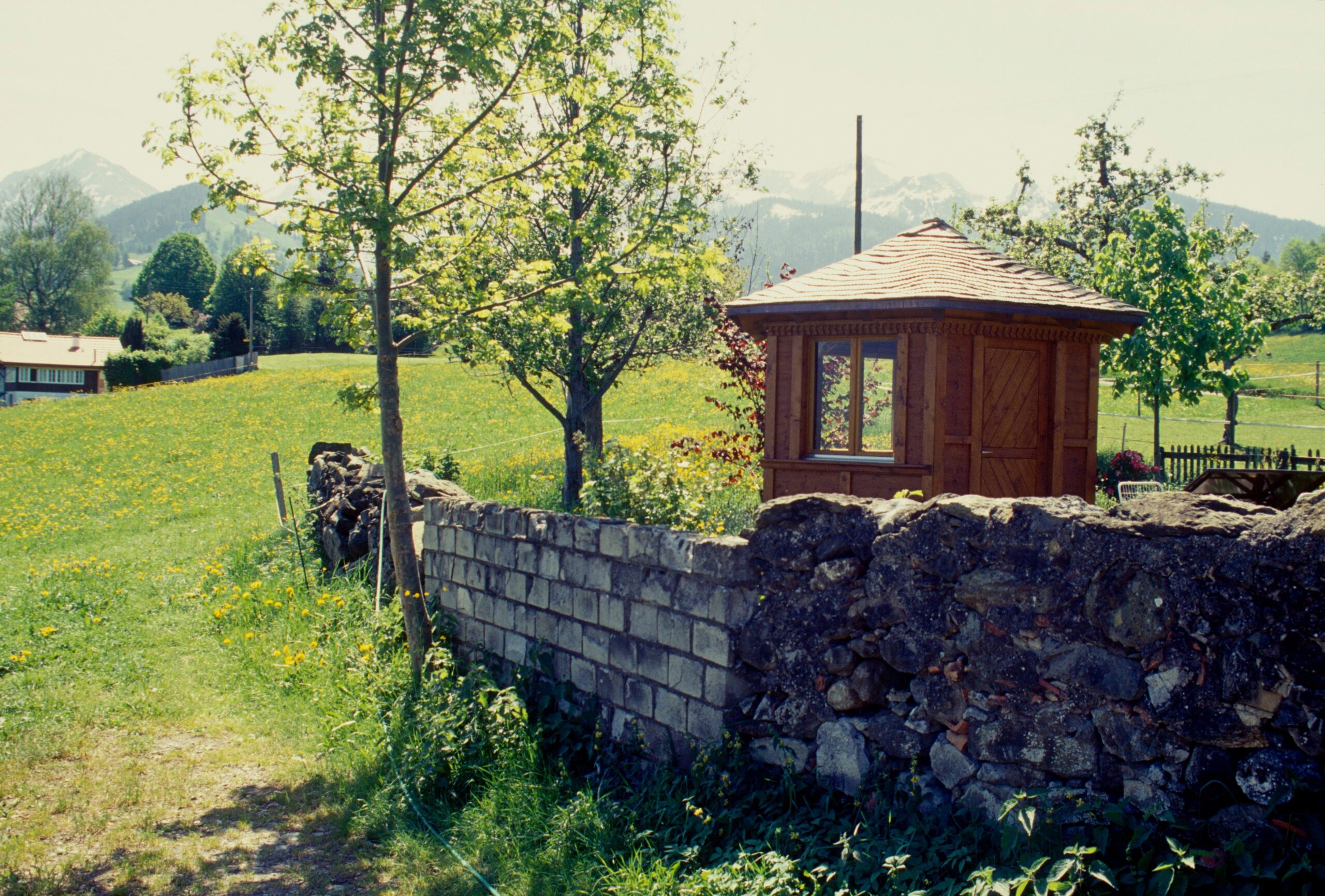
The next child of the Beetschen family, Friedrich (shortened to Fred) was born on December 17, 1851, and baptized in Muenster on February 1, 1852. After a lot of guessing, I finally found out that this is the German name for Moutier [in the French-speaking part of Switzerland], because Eduard, who was born on March 13, 1853, was baptized in Muenster-Dachsfelden on April 10. Dachsfelden is identical to Tavannes, which is near Moutier. The Beetschen-family therefore migrated to the Bernese Jura, where French is the official language. This makes the story more comprehensible whereby Rosina had been bilingual (German/French).
Now, the trickier questions arose: Where did the Kaspar and Rosina meet? How did the Catholic Bruehlmeier get the thought and the chance to marry a Protestant from the Bernese Jura? I got the information from America that the two arrived in New York in August of 1869 and by December 29 of the same year, according to a document, their oldest son, Friedrich August Bruehlmeier was born. All of us who were involved in solving this puzzling problem developed the most adventuresome theories: the two could have met between Basel and Amsterdam, perhaps they made a stop in Kapsweyer, maybe they were married on the ship, etc. I developed a sudden interest in their passage over the Atlantic and started to gather information about ships that had crossed the ocean in 1869. With some luck, I found the research institution of the University of Oldenburg [Germany] on the Internet, and (for a fee) the employee in charge looked for the name, Kaspar Bruehlmeier. She reported that only a Caspar Bruhleman from Germany could be found, and I ceased to follow this trail. Fortunately, I received a copy of the relevant page of the passenger list. To my surprise, I discovered that just a few lines below the entry of the name Caspar Bruhleman, 6 members of the Beetschen family were listed, namely the father, Christian, the mother Susanna, the sons, Fritz and Eduard, as well as the two daughters, Rosina and Louisa. Interestingly, the place of origin was indicated as Germany, but this is true for all the people listed on this page. At the top of the page, “Germany” was listed once and then followed by 57 quotation marks [short for ditto], almost as if drawn by a ruler from the top to the bottom. It shows that the writer did not fill in this row after every notation of a name, but mechanically used the small ditto-marks from the top to the bottom. I learned from experts that the English ship’s officers did not know German so they not only wrote down every name the way it seemed right to them (in this example Betschan), but also regarded everybody as German who spoke German. Thus, our Kaspar Bruehlmeier was renamed Caspar Bruhleman and was turned from Swiss to German by these ditto-marks, just like the clearly Swiss Beetschen had had their nationality changed to German. At least ages appear to be correct. I then ordered a copy of the complete passenger list. It proves that Kaspar and the Beetschen family left from Antwerp [Belgium] on the ship called “City of Dublin” under the command of Captain John Eynon, and arrived in New York on June 29, 1869.
The newly found passenger list answered several questions, but still leaves much to speculation. It is certain that the two were not yet married when they boarded the ship, because if that were the case, Rosina would have been listed as the wife of Kaspar. Still, she was already pregnant and the logical question is, “by whom?” If it was by Kaspar, he must have known Rosina and her family for at least three months before they left Moutier. Was he working in this area as a traveling journeyman? Was Rosina working as a maid in our area? Or, did the family Beetschen emigrate for the then common economical reasons and did Kaspar start his journey independently?
It is astounding that there are no obvious traces of the emigration of Kaspar in the documents of Wettingen. If there had been any hint of Kaspar’s emigration, Mr. Spiegelberg would certainly have found and documented it, because he diligently researched the problematical emigration records and noted every person who submitted a request for emigration or financial assistance to the local council. There seem to be two possible explanations for this uncommon behavior. Either Kaspar, as a member of the Rebmeister-line, did not depend on the financial support of this community and organized his emigration totally by himself, (though that would have been most unusual at the time). Or, he left his homeland in quite a hurry for undisclosed reasons, and covered his tracks intentionally. The latter theory would better explain the whole Kapsweyer story. Under these presumptions, it would also become clear why Kaspar boarded a ship in Antwerpen, even though the local council of Wettingen had a contract with an “Emigration Shipper.” This Emigration Shipper, Josef Rufli, Adlerwirt, [the host of the Restaurant Adler] in Sisseln, a small town about 20 miles from Wettingen, had all emigrants traveling to Le Havre in France.
Today, it seems most probable to me that Kaspar met Rosina somewhere (either in the Bernese Jura or in our region), fell in love and, after he knew she was pregnant, went on his journey to America as quietly and inconspicuously as possible. Perhaps as a descendant of wealthy parents, he even financed the trip for the whole Beetschen family. The fact that he did not want to marry in Switzerland under these circumstances is understandable. If everything had become public in Wettingen, it would have thrown a long shadow upon the well-regarded family, not only because of Rosina’s out-of-wedlock pregnancy, but even more because of her Protestant confession. This also makes it understandable that one did not hear of Kaspar anymore thereafter, and without the messages from America, he would be completely forgotten by now.
Today, Kaspar (along with Rosina) have been awarded special honors through my work of research, because on November 12, 2001, a new and richly illustrated book (180 pages) has been published about the village of Wettingen from its development to the present day. During the course of this project, I had the opportunity to have included in this book the only known pictures of Kaspar and Rosina. The two can be found on page 39 of the new book, as representatives of all citizens of Wettingen who immigrated to America. Under the two pictures, the comment reads: “Kaspar Leonz Bruehlmeier and Rosina Beetschen sailed with the ‘City of Dublin’ from Antwerp to New York in 1869. They married soon after their arrival and moved on to Texas.”
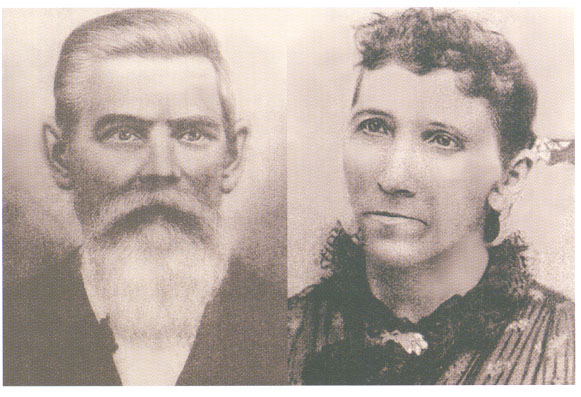
Kaspar and Rosina Bruehlmeier-Beetschen in the new book of Wettingen
It can not be completely discounted, however, that Kaspar met his Rosina only after boarding the ship and fell in love there. In that case, it could have only been a welcome solution to a problem for both Rosina and her parents. If that was the situation, the child that was already on its way, was fortunate to be gaining a legitimate father. Under those circumstance, the descendants of Rosina’s oldest son, Friedrich August Bruehlmeier, would have accept that they are descendants of the Bruehlmeier family in name only.
This is not the proper place to reveal the amount of information that was exchanged between the different descendants of Kaspar, my son Matthias, and me regarding facts, memories, stories and suppositions as we finally established the facts, such a they are. It can certainly be regarded that Kaspar was very skilled as a craftsman and was extraordinarily knowledgeable in viticulture. All in all, there is the ultimate impression that he was, and remained, an in-law of the Beetschen family. Of course, he must have always been available to lend a hand and probably also enjoyed great respect because of his previous social status and probably because, as a descendant of the famous Rebmeister-line, he was also disposed of some wealth. As already mentioned, this line has died out in Switzerland, but developed very well in America, mainly in Texas, where today, more than 60 persons who are related to Kaspar, are bearing the name Meyer or Meyers. The details can be extracted from the family tree.
Only a short time ago, I succeeded in finding the house of Kaspar’s parents in the center of the Unterdorf [historically the lower part of the village] of Wettingen. His father, Johann Bruehlmeier-Knecht, had bought it from a Kaspar Bernhard Huser and bequeathed it to his son, Gottlieb Bruehlmeier-Luethy, upon his death. Gottlieb died without children on December 26, 1925 and bequeathed the house to his maid, Magdalena Steimer, who then donated it to the Catholic parish of Wettingen in 1928 with the condition that it be used as a gathering place for the Catholic organizations of Wettingen. Beginning 1943, I was a member of a Catholic youth group called “Jungwacht.” I spent many afternoons and evenings with my friends in the rooms of this house, which at that time were still in their original state. Without realizing it, I spent a lot of time in the very rooms in which Kaspar had grown up. The Catholic organizations later received better rooms and the former farmhouse was rebuilt as a kindergarten. Today, it is again in need of renovations and my brother Josef has been put in charge of researching the former owners for appointment as a member of the committee. As it turned out, our works of research nicely complemented each other. On November 19, 2001, a report in the Badener Zeitung, (part of the Aargauer Zeitung) the most important local newspaper, was printed and included information on the upcoming renovation of the house, on his and my works of research, and also featured a picture of the house.
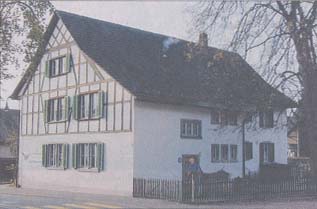
In this house Kaspar Bruehlmeier was borne.
At this place, I would like to mention the following family members who contributed
significantly to this research work and to the translation into English:
Darlene Gaitan, Gainesville (Texas)
Sammie Hunter, Gainesville
William Meyer, Fort Worth (Texas)
Sherie Hodges. Oklahoma City
I thank them for their help und friendly contact.
